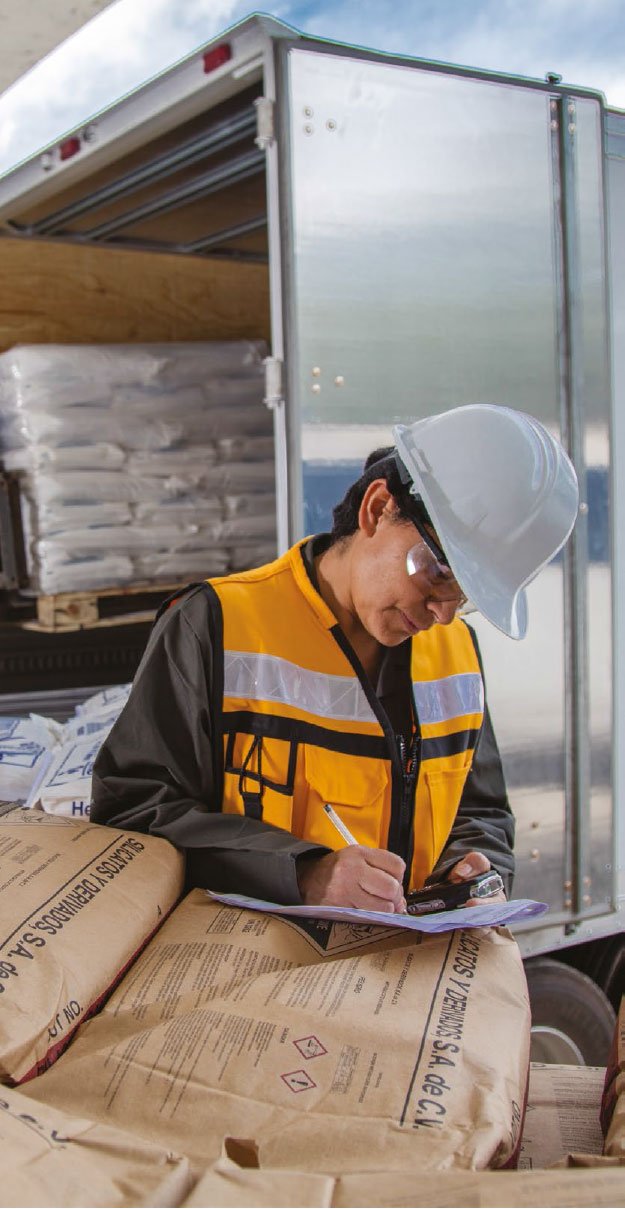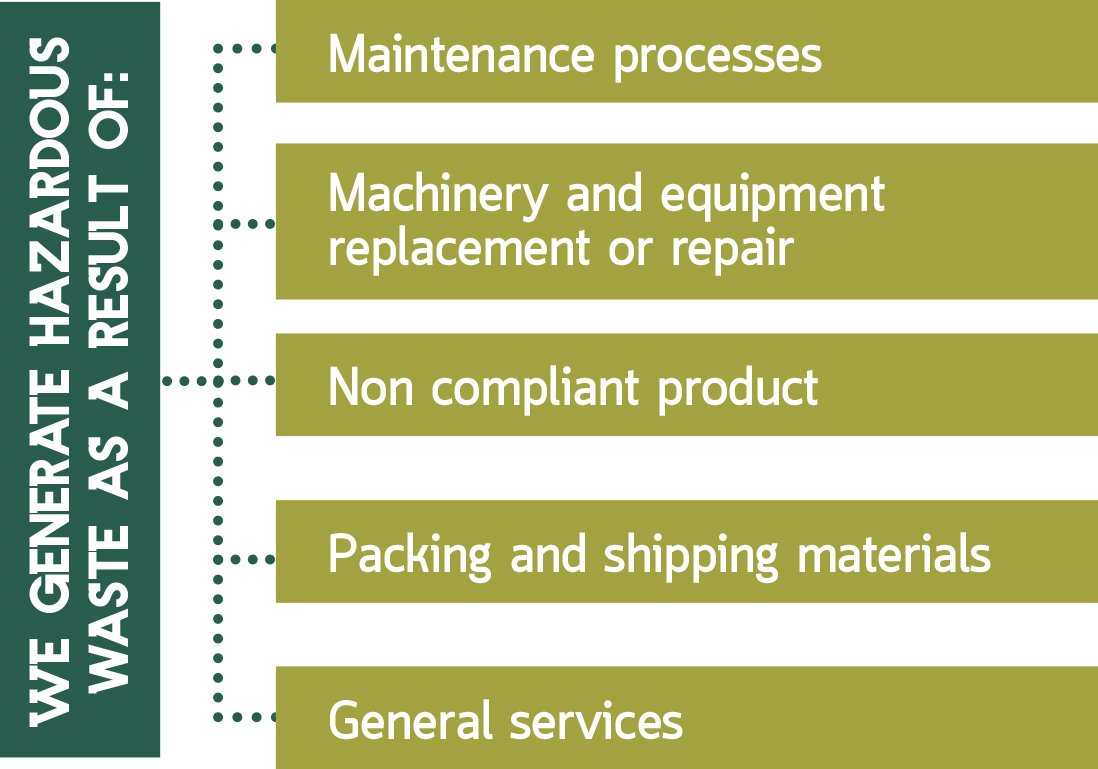GRUPO POCHTECA

A SUSTAINABLE COMPANY

We are aware of our responsibility to the
environment. For that reason we strictly abide by
national and international standards for identifying,
managing and resolving problems that can arise in
this regard. We also intend to expand and improve
our product catalogue in ways that can contribute to
mitigate the impact we generate.
The environment is one of the values that guide
our management strategy. For that reason, we
maintain compliance with municipal, state and federal
regulations. These obligations are considered part
of the control, monitoring and reports included
in our IMS (Integrated Management System)
nationwide. These reports are reviewed each month
by Management to assure that we maintain the
necessary compliance.
In 2015, we went through three environmental inspections, two of which were by federal authorities and the other by a state authority. These took place in the State of Mexico and Puebla and led us to pay Ps 51,000 in fines. The violations detected in each instance were addressed promptly and to the full satisfaction of the authorities.
In addition to such governmental inspections, our clients and suppliers conduct an annual environmental performance evaluation through second and third hand audits.
In 2015 we were the subject of 14 audits, ten of which comprised environmental aspects. In all of these, we received favorable evaluations and in some cases suggestions for improvement.
The results of such verifications are communicated to the organization through our communications and collaboration portal pochtecaNET. Moreover, we share each branch’s performance though their site within this same portal.
Leaks and spills are among the environmental risks we contemplate in our operational risk matrix. To that end we have the necessary infrastructure and equipment both for storage and transport containment of liquids as well as very specific emergency protocols and procedures.
The ratio of kilos removed to the amount of liters spilled was 0.00002%.
The most significant event in 2015 took place at our San Luis Potosí branch, where we experienced a spill of 1,586 liters of methanol and 543 liters of thinner.
In all cases, the spills experienced took place in the primary contention zones designated for managing the product in question, which is to say on concrete surfaces that included containment ditches. The spilt material was collected and disposed in accordance with our procedures for handling hazardous waste.
In our investigation of these spills, we identified the need for training our forklift operators, and we proceeded to include such additional instruction on top of what was already contemplated in our annual training plan.
These events had a Ps 103,000 economic impact.

9 spills
4,123 liters lost
Water EN9
The supply of water for all of our facilities except that of Cancun comes from municipal waterlines or from the purchase of tanker trucks of water. Only the Cancun facility has its own well because it exclusively uses that resource for its sanitation needs. For the year, we are within the level of water consumption authorized by Mexico’s National Water Commission (CONAGUA).
Emissions G4-EN15, G4-EN16, G4-EN17
Direct emissions
For the first time we conducted an estimation of the CO2 emissions generated by our processes.
This calculation was limited to the consumption of electricity, gasoline and diesel, as well as mobile sources, which due to the nature of our business extend only to storage and distribution activities. These emissions are generated by our transport vehicles and not by any processing equipment, which is to say fixed sources. For purposes of calculating these values we employed the emissions calculator of the National Emissions Registry (RENE) published by Mexico’s Ministry of the Environment and Natural Resources (SEMARNAT).
In all of these cases, we will use the year of this report (2015) as a reference point for future comparisons in relation to results from subsequent years.
507.3 TonS
CO2 Direct Emissions
240.6 TonS
CO2 INDirect Emissions
We have undertaken a number of actions aimed at lowering our greenhouse gas emissions that are basically focused on our transportation vehicles.
We made the following improvements to our supply chain process compared to 2014:
- An 11% reduction in inventory from Ps 699 million to Ps 627 million
- We lowered by 2% our rate of error in forecasting the amount of inventories needed to fulfill sales, which fell from 18% to 16%.
G4-EN20
We have 1,349 extinguishers nationwide, 80% of
which are dry chemical powder units and the rest CO2 and water extinguishers; we lack any halon
extinguishers. We are currently taking bids for
the procurement of environmentally sound, nonhazardous,
non-corrosive, biodegradable, non-toxic,
and CFC’s free dry chemical extinguishers, that are
to be installed in 2016.
Requirements in environmental legislation are one of the main criteria to be used when evaluating possible new projects. For that reason, during the year we requested the necessary permits and studies for the installation and operation of three solvent distillation units at our facilities in the city of León, Guanajuato.
Waste
G4-EN23, G4-EN27, G4-EN28, G4-DMA EFFLUENTS
AND WASTE, PRODUCTS AND SERVICES

G4-DMA EFFLUENTS AND WASTE
In all cases, effluents and waste are disposed in
a responsible manner in keeping with SEMARNAT
legislation. Most of our installations have been
registered as being “small hazardous waste
generators” and only three of our installations
as “major hazardous waste generators”. In no
case did they surpass the maximum quantity
limits that would alter those categories.
G4-EN27
In order to reduce the amount of waste, we have
sales processes, procedures, controls and, when
necessary, the permits needed under the applicable
regulatory norms.
Non-compliant material for clients. We sell noncompliant material to clients whose processes allow them to employ such materials, informing them before hand of the product’s status and obtaining their consent to receive the product through the evaluation of a sample. We sold 778 tons of products under such arrangements.
Machinery and equipment as scrap. This process includes applying for the necessary permits from SEMARNAT depending on the type of product being offered. Our scrap sales totaled Ps 117 thousand in 2015.
Drums
We lowered our waste generation by washing and
controlling returns of drums.
Tires
At the end of their useful life, we return tires to their
suppliers, who provide us with documentation as to
their reception and final disposal.
Paper
Waste from the conversion of paper, board, plastic and
wood containers and wrapping is sold for recycling.
318 tons
Materials G4-EN1, G4-EN2
| Container | Total |
|---|---|
| Metal drum | 473,472 |
| Plastic jugs | 363,665 |
| Metal buckets | 87,978 |
| Plastic drums | 63,647 |
| Plastic cans | 16,625 |
| Metal cans | 1,723 |
| Wood Pallets | 173,232 |
| Overall Total | 1,180,341 |
G4-EN27
By washing the metal drums in our San José and
Minatitlán plants, we were able to reuse 89% of them
at an effective rate of 4.5 turns per drum. Used wood
pallets are purchased and reconditioned locally. The
effective rate of re-use was 78%.
G4-EN31
The budget expenditure lines we have assigned for
environmental protection are as follow:
- Permits and studies Ps 551,447
- Legal advisory services Ps 530,956
- Investments: Ps 35 million in three solvent recovery units
